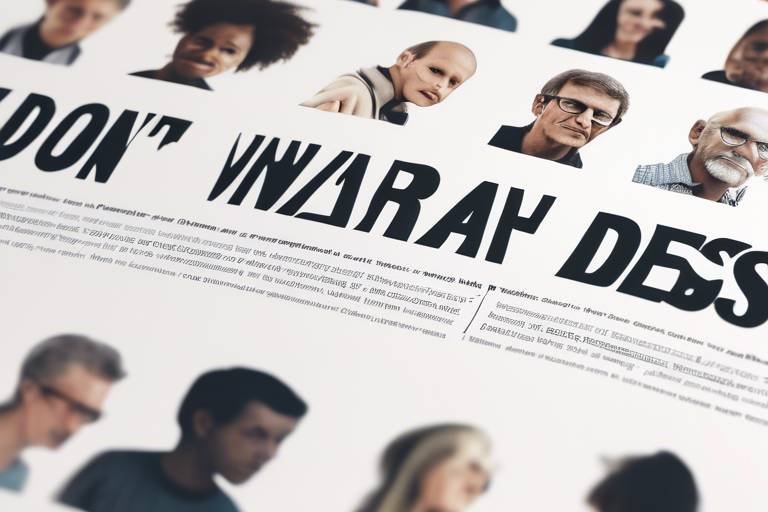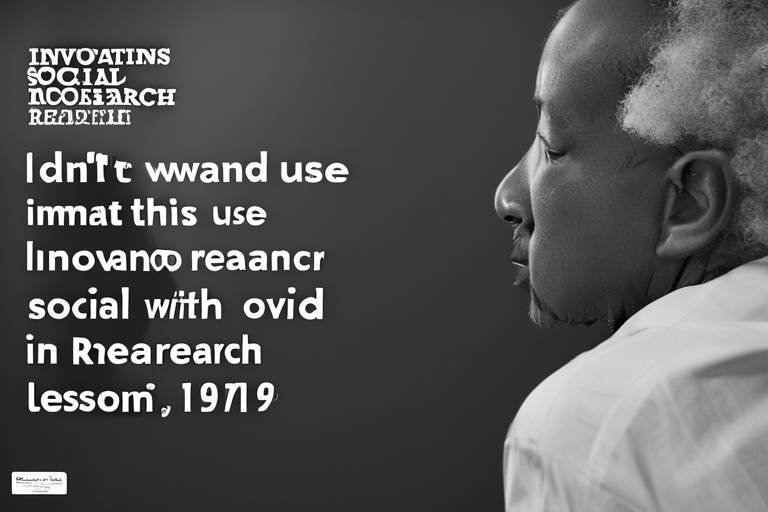The Science of Participatory Design in Research
Participatory design is more than just a buzzword; it's a transformative approach that reshapes how we think about research and innovation. Imagine a world where the voices of users are not just heard but actively shape the outcomes of projects. This is the essence of participatory design—a collaborative endeavor that invites stakeholders into the creative process, ensuring that their needs and insights are front and center. As we dive deeper into this fascinating field, we'll uncover its origins, principles, and the profound impact it has on fostering inclusivity and creativity in research.
At its core, participatory design is about collaboration. It originated in the 1970s, primarily within the realms of architecture and urban planning, as a response to the often top-down approaches that neglected the voices of those directly affected by design decisions. Key principles of participatory design include inclusivity, where diverse stakeholders engage in the design process, and co-creation, emphasizing that the best solutions arise from collective input. By integrating the perspectives of users, researchers can create more relevant and effective solutions that resonate with real-world needs.
Engaging users in the design process isn't just a nice-to-have; it's a game changer. The benefits of participatory design are numerous and impactful. For instance, when users are involved, the likelihood of achieving improved user satisfaction skyrockets. Why? Because the solutions are tailored to their actual needs, not assumptions. Moreover, this collaborative approach fosters enhanced innovation. When diverse minds come together, ideas flow freely, leading to creative breakthroughs that would be hard to achieve in isolation. This is particularly crucial in fields where understanding user experience is key to success.
But how do we ensure that users are genuinely engaged? It starts with creating an environment where their voices are not just heard but valued. Strategies such as workshops, focus groups, and co-design sessions can be incredibly effective. These methods not only empower users but also facilitate a sense of ownership over the design process. When users feel that their input matters, their engagement deepens, leading to richer insights and more meaningful outcomes.
Trust is the glue that holds participatory design together. Without it, collaboration can falter. Building trust involves consistent communication and a genuine commitment to understanding user needs. Designers and researchers must invest time in nurturing relationships with stakeholders, which can lead to more fruitful collaborations. When users trust the process and the people behind it, they are more likely to share their honest opinions and experiences, ultimately enriching the design process.
Open communication is another cornerstone of effective participatory design. Techniques such as regular feedback loops, transparent decision-making, and inclusive dialogue can foster an atmosphere where everyone feels comfortable sharing their thoughts. This not only ensures that all voices are heard but also enhances the collective understanding of the challenges and opportunities at hand. When stakeholders engage in open dialogue, they can navigate complexities together, leading to more robust and effective design outcomes.
Despite its many advantages, participatory design is not without challenges. Common obstacles include power dynamics, where certain voices may dominate the conversation, and resource constraints that limit engagement opportunities. Additionally, balancing the diverse needs and expectations of various stakeholders can be daunting. However, acknowledging these challenges is the first step toward overcoming them. By implementing strategies that promote equity and inclusivity, researchers can navigate these hurdles and fully harness the power of participatory design.
Real-world examples of participatory design illustrate its transformative potential. Across various sectors, from technology development to urban planning, participatory design has led to innovative solutions that truly reflect the needs and desires of users. These case studies highlight not only successful implementations but also the lessons learned along the way, providing valuable insights for future projects.
In the realm of technology, participatory design has revolutionized product development. By involving users in the design of digital products, companies can create solutions that are not only user-friendly but also effective in meeting real-world challenges. This collaborative approach can lead to products that resonate deeply with users, enhancing their overall experience and satisfaction.
Urban planning is another field that thrives on participatory design. Community involvement is crucial in shaping sustainable and inclusive urban environments. By engaging residents in the planning process, cities can better reflect the needs and desires of their communities, leading to spaces that are not only functional but also vibrant and welcoming.
- What is participatory design? Participatory design is a collaborative approach that involves stakeholders in the design process to ensure their needs and insights shape the outcomes.
- What are the benefits of participatory design? Benefits include improved user satisfaction, enhanced innovation, and solutions that are tailored to real-world needs.
- How can user engagement be enhanced? Strategies such as workshops, focus groups, and co-design sessions can actively involve users in the design process.
- What challenges does participatory design face? Common challenges include power dynamics, resource constraints, and balancing diverse stakeholder needs.

Understanding Participatory Design
Participatory design is not just a buzzword; it's a transformative approach that revolutionizes how we think about design processes. Imagine a world where the end-users of a product or service are not merely passive recipients but active participants in shaping their experiences. That's the essence of participatory design! It originated in the 1970s, primarily in Scandinavia, as a reaction against traditional design methods that often excluded the very people who would use the products. By involving stakeholders right from the outset, participatory design fosters a sense of ownership and ensures that solutions are not only innovative but also relevant and practical.
The key principles of participatory design revolve around inclusivity, collaboration, and empowerment. Inclusivity means that diverse voices are heard—whether they are users, community members, or other stakeholders. Collaboration emphasizes teamwork and shared decision-making, while empowerment focuses on giving participants the tools and agency to influence the design process. This triad of principles is what makes participatory design so powerful.
In practice, participatory design can take many forms. For instance, workshops where users brainstorm ideas, co-design sessions where they sketch out concepts, or feedback loops where prototypes are tested and refined based on user input. These methods not only generate creative solutions but also build a sense of community among participants. When people come together to solve a problem, they often find that their collective knowledge and experiences lead to insights that no individual could have achieved alone.
Moreover, participatory design is particularly effective in fostering creativity. By breaking down the barriers between designers and users, it creates an environment where ideas can flow freely. Think of it like a jam session in music—when everyone contributes, the final product is often a harmonious blend of various influences, resulting in something truly unique and valuable.
Ultimately, understanding participatory design is about recognizing its potential to create solutions that resonate with real-world needs. It's about shifting the paradigm from a top-down approach to one that values every participant's input. As we move forward in various fields, embracing this collaborative mindset can lead to innovations that are not only effective but also sustainable and equitable.

Benefits of Participatory Design
Participatory design is more than just a trendy buzzword; it’s a powerful approach that transforms the way we think about design and research. By actively involving users and stakeholders in the design process, this methodology opens up a world of advantages that can lead to innovative solutions and enhanced satisfaction. Imagine a scenario where the end users are not just passive recipients of a product but active contributors to its development. This shift in perspective can result in outcomes that are not only more effective but also deeply resonant with the needs and desires of those they serve.
One of the most significant benefits of participatory design is the improvement in user satisfaction. When users are involved in the design process, they feel a sense of ownership over the final product. This emotional investment often translates into a higher level of satisfaction. Think about it: wouldn’t you be more pleased with a product that reflects your input and ideas? This sense of ownership fosters loyalty and can lead to long-term relationships between users and designers.
Moreover, participatory design enhances innovation by tapping into the diverse perspectives of a wide range of stakeholders. By bringing together different voices, teams can generate a wealth of ideas that may not have emerged in a traditional design process. For instance, in a recent project aimed at developing a new healthcare app, designers involved patients, healthcare professionals, and even IT specialists. The result? A user-friendly app that not only met clinical needs but also made patients feel more empowered in their healthcare journey.
Another crucial aspect is the ability to create solutions that are tailored to real-world needs. Unlike conventional methods that often rely on assumptions, participatory design ensures that the solutions developed are grounded in actual user experiences. This leads to more effective products that address specific challenges faced by users. For example, in urban planning, involving community members in discussions about public spaces can lead to designs that genuinely reflect the community’s needs, such as parks that cater to families or areas that promote social interaction.
To summarize the benefits of participatory design, let’s take a look at the following table that encapsulates its key advantages:
| Benefit | Description |
|---|---|
| Improved User Satisfaction | Involving users creates a sense of ownership and emotional investment. |
| Enhanced Innovation | Diverse perspectives lead to a wealth of creative ideas. |
| Effective Solutions | Solutions are tailored to actual user needs, not assumptions. |
In addition to these benefits, participatory design can also foster a culture of collaboration and trust among stakeholders. When users feel that their opinions are valued, they are more likely to engage openly and share their insights. This open atmosphere can lead to more meaningful discussions and ultimately a more successful design process. The bottom line is that participatory design not only enriches the design process but also enhances the overall outcomes, making it a win-win for everyone involved.
- What is participatory design? Participatory design is a collaborative approach that involves users and stakeholders in the design process to create solutions that meet their needs.
- How does it improve user satisfaction? By involving users in the design process, they feel a sense of ownership and investment in the final product, leading to higher satisfaction.
- Can participatory design be applied in all fields? Yes, it can be applied in various fields such as technology, urban planning, healthcare, and more.

Enhancing User Engagement
When it comes to participatory design, user engagement is not just a checkbox to tick off; it’s the lifeblood of the entire process. Imagine trying to create a delicious recipe without tasting it—sounds absurd, right? Well, that’s exactly what happens when designers work in isolation, far removed from the very people who will use their creations. Engaging users actively not only enhances the design but also cultivates a sense of ownership among them. This involvement can take many forms, from workshops and focus groups to interactive prototyping sessions, where users can provide real-time feedback.
To truly enhance user engagement, it’s essential to create an environment where participants feel comfortable sharing their thoughts. This means designing activities that encourage open dialogue and collaboration. For instance, using tools like brainstorming sessions or design charrettes can lead to innovative solutions that might not surface in traditional meetings. The key is to ensure that every voice is heard and valued. When users see their ideas reflected in the final product, it not only boosts their satisfaction but also increases the likelihood of success for the project.
Moreover, employing a variety of engagement techniques can cater to different preferences and learning styles. Some users might thrive in hands-on activities, while others might prefer written surveys or digital feedback forms. By diversifying the methods of engagement, designers can tap into a broader spectrum of insights, leading to richer, more nuanced outcomes. For example, consider the following approaches:
- Workshops: Interactive sessions where users can brainstorm and prototype ideas together.
- Surveys: Collecting structured feedback from a larger audience to gather diverse opinions.
- Usability Testing: Observing users as they interact with prototypes to identify pain points and areas for improvement.
Incorporating these strategies not only enhances user engagement but also fosters a culture of collaboration. When users feel that their opinions matter, they become more invested in the project, leading to deeper insights and more effective solutions. This collaborative spirit can be likened to a well-orchestrated symphony, where each instrument contributes to a harmonious whole. The result? A design that resonates with users on multiple levels.
Ultimately, enhancing user engagement is about building relationships. It’s about creating a space where users can express their needs and desires freely. When users are engaged, they become co-creators in the design process, which leads to outcomes that are not only innovative but also genuinely reflect the community's needs. So, the next time you embark on a design project, remember: the more you engage your users, the more successful your project will be.
Here are some common queries about enhancing user engagement in participatory design:
- What is the best way to engage users in the design process?
Using a combination of workshops, surveys, and usability testing can effectively engage users and gather valuable insights.
- How do I ensure all voices are heard during the engagement process?
Creating an open and inclusive environment, using diverse engagement methods, and actively encouraging participation can help ensure that everyone’s voice is valued.
- What are the benefits of engaging users in design?
Engaging users leads to better-designed products that meet real needs, increased user satisfaction, and a stronger sense of ownership among participants.

Building Trust and Relationships
In the realm of participatory design, trust is not just a nice-to-have; it’s the very foundation upon which successful collaborations are built. Imagine a bridge: without a solid structure, it simply won’t hold. Similarly, without trust, the connection between designers and users can become fragile, leading to misunderstandings and ineffective outcomes. So, how do we go about building this essential trust?
First and foremost, it’s vital to establish authentic relationships with all stakeholders involved. This means taking the time to get to know them—not just as users, but as individuals with unique experiences and perspectives. When designers show genuine interest in the users’ needs and aspirations, it fosters a sense of belonging and respect. Picture this: you’re at a dinner party, and the host takes the time to engage you in conversation. You’re more likely to feel valued and comfortable, right? The same principle applies here.
Moreover, transparency plays a crucial role in building trust. When stakeholders are kept in the loop about project developments, decisions, and challenges, it creates a culture of openness. This can be achieved through regular updates and feedback sessions. Think of it as a two-way street: the more information shared, the more trust is cultivated. By actively inviting feedback and acknowledging it, designers can demonstrate that users’ opinions are not just heard, but are integral to the design process.
Another important aspect is to ensure that all voices are valued equally. In participatory design, it’s common for power dynamics to emerge, where certain stakeholders may dominate discussions. To counteract this, facilitators can employ strategies such as:
- Creating a safe space for all participants to express their thoughts.
- Using anonymous feedback tools to gather honest opinions.
- Encouraging quieter members to share their insights through structured activities.
By implementing these strategies, designers can help ensure that everyone feels empowered to contribute, which in turn strengthens the collaborative spirit and builds trust.
Finally, it’s essential to acknowledge and celebrate the contributions of all stakeholders. Recognizing individuals for their input not only boosts morale but also reinforces the idea that collaboration is a shared journey. When users see their ideas reflected in the final design, it solidifies their trust in the process and the people behind it. In essence, building trust and relationships in participatory design is akin to nurturing a garden: it requires patience, care, and a commitment to growth. By investing in these relationships, we pave the way for more meaningful collaborations and successful outcomes in our projects.
- What is participatory design? Participatory design is a collaborative approach that involves stakeholders in the design process, ensuring their voices and insights are integrated into the final outcomes.
- Why is trust important in participatory design? Trust fosters open communication and collaboration, making it easier for stakeholders to share their ideas and feedback, ultimately leading to better design outcomes.
- How can I build trust with stakeholders? Building trust involves establishing authentic relationships, maintaining transparency, valuing all voices equally, and recognizing contributions throughout the design process.

Facilitating Open Communication
When it comes to participatory design, the importance of open communication cannot be overstated. It's like trying to build a bridge without talking to the people on the other side; you might end up with a structure that no one wants to cross! Open communication fosters an environment where all stakeholders feel comfortable sharing their thoughts, ideas, and concerns. By ensuring that everyone is on the same page, we can create a more cohesive and effective design process.
To facilitate open communication, it’s crucial to create a safe space for dialogue. This means encouraging honesty and transparency among all participants. One effective strategy is to hold regular meetings where stakeholders can come together to discuss progress and share feedback. These meetings should be structured yet flexible enough to allow for spontaneous discussions. Think of it as a potluck dinner; everyone brings something to the table, and the more diverse the dishes, the richer the experience!
Another technique is to utilize digital tools that promote collaboration. Platforms like Slack, Trello, or Miro can help keep everyone connected, especially in remote settings. By using these tools, stakeholders can share documents, brainstorm ideas, and track progress in real-time. It’s like having a virtual workshop where everyone can contribute, regardless of their location.
Moreover, it’s essential to actively listen to all voices in the room. This means not just hearing what people say but truly understanding their perspectives. Implementing active listening techniques can help in this regard. For instance, paraphrasing what someone has said can show that you value their input. It’s akin to a dance; when one partner leads, the other must follow, ensuring a harmonious flow.
Finally, it’s important to document discussions and decisions made during meetings. This not only serves as a reference point but also reinforces accountability among stakeholders. A simple
| Date | Discussion Points | Action Items |
|---|---|---|
| 01/01/2023 | Initial project brainstorming | Draft project outline |
| 01/15/2023 | Feedback on project outline | Revise outline based on feedback |
In conclusion, facilitating open communication is the backbone of participatory design. By creating a safe and inclusive environment, utilizing digital tools, practicing active listening, and documenting discussions, we can ensure that every voice is heard, leading to more innovative and effective design solutions. Remember, when everyone contributes, the end product is not just a design; it’s a shared vision brought to life!
Q1: What is participatory design?
A1: Participatory design is a collaborative approach that actively involves stakeholders in the design process to ensure their needs and perspectives are considered.
Q2: How can I encourage open communication in my team?
A2: Create a safe environment for dialogue, utilize collaborative tools, practice active listening, and document discussions to keep everyone informed.
Q3: What are the benefits of open communication in participatory design?
A3: Open communication leads to better collaboration, increased trust, and ultimately more innovative and effective design solutions that meet real-world needs.

Challenges in Implementing Participatory Design
Participatory design, while incredibly beneficial, is not without its challenges. One of the most significant hurdles is the power dynamics that often exist between stakeholders. In many cases, designers may inadvertently dominate the conversation, leading to a situation where the voices of users and other stakeholders are overshadowed. This can create a sense of disenfranchisement among participants, making them less likely to contribute meaningfully. It’s crucial to recognize that every participant has valuable insights to offer, and their input should be actively sought and respected.
Another challenge is the resource constraints that many projects face. Engaging users effectively can be time-consuming and may require additional funding to facilitate workshops, meetings, and feedback sessions. Not all organizations have the luxury of ample resources, which can lead to rushed processes or superficial engagement. This often results in a disconnect between the design output and the actual needs of the users.
Moreover, there’s the issue of varying levels of expertise among participants. When users come from different backgrounds, their familiarity with design processes can differ significantly. This disparity can lead to misunderstandings or miscommunications, making it difficult to achieve a cohesive design vision. Designers must be adept at bridging this gap, ensuring that all voices are heard and understood, regardless of their technical knowledge.
In addition, logistical challenges can arise, especially when coordinating schedules among diverse stakeholders. Finding a common time for everyone to meet can feel like trying to solve a Rubik’s Cube blindfolded! This can hinder the continuous dialogue essential for participatory design. To overcome this, utilizing digital tools for collaboration can help streamline communication, allowing for asynchronous contributions and discussions.
Finally, the cultural differences among participants can also pose challenges. Different backgrounds may lead to varying expectations about the design process, communication styles, and decision-making approaches. Designers must navigate these differences with sensitivity and awareness, fostering an environment of inclusivity where all participants feel comfortable sharing their perspectives.
In summary, while participatory design presents numerous opportunities for innovation and user-centered solutions, it is essential to be aware of the challenges that can arise. By addressing power dynamics, resource constraints, varying expertise, logistical issues, and cultural differences, designers can create a more effective and inclusive participatory design process that truly reflects the needs and desires of all stakeholders involved.
- What is participatory design? Participatory design is a collaborative approach to design that actively involves stakeholders, especially users, in the design process to ensure their needs and insights are integrated.
- Why is user engagement important in participatory design? User engagement is crucial because it leads to designs that are more relevant, effective, and satisfying to the end-users, ultimately resulting in better outcomes.
- What are some common challenges in participatory design? Common challenges include power dynamics, resource constraints, varying levels of expertise among participants, logistical issues, and cultural differences.
- How can designers overcome these challenges? Designers can overcome these challenges by fostering open communication, being aware of power imbalances, utilizing digital tools for collaboration, and promoting inclusivity throughout the design process.

Case Studies of Participatory Design
Participatory design is not just a theoretical concept; it has been successfully implemented across various sectors, yielding remarkable results. These real-world case studies highlight how engaging stakeholders in the design process can lead to innovative solutions that truly resonate with users. One notable example comes from the healthcare sector, where hospitals have employed participatory design to enhance patient experiences. By involving patients, healthcare providers, and designers in collaborative workshops, hospitals have been able to redesign waiting areas and treatment rooms to better meet the needs of patients and their families. This approach has not only improved patient satisfaction but also increased the overall efficiency of healthcare delivery.
Another compelling case study is found in the realm of urban planning. In a city striving for sustainability, local government officials organized community design sessions to gather input on a new public park. Residents were encouraged to share their ideas and preferences, which were then translated into actionable design elements. The result was a park that not only serves as a recreational space but also incorporates community gardens, walking trails, and areas for public events. This participatory approach ensured that the park reflected the desires and needs of the community, fostering a sense of ownership and pride among residents.
In the technology sector, participatory design has proven invaluable during the development of digital products. For instance, a software company launched a series of focus groups with potential users to gather feedback on a new application. By involving users early in the design process, the company was able to identify pain points and desired features that may have otherwise gone unnoticed. This direct input led to the creation of a more intuitive and user-friendly product, ultimately resulting in higher user adoption rates and satisfaction.
To further illustrate these points, let's take a look at a comparative table of these case studies:
| Sector | Project | Stakeholders Involved | Outcome |
|---|---|---|---|
| Healthcare | Patient Experience Redesign | Patients, Healthcare Providers, Designers | Improved patient satisfaction and efficiency |
| Urban Planning | Community Park Design | Residents, Local Government, Designers | A park that meets community needs and fosters pride |
| Technology | Application Development | Potential Users, Developers, Designers | Higher user adoption and satisfaction |
These case studies demonstrate the profound impact of participatory design across diverse fields. By engaging users and stakeholders in the design process, organizations can create solutions that are not only effective but also meaningful. This collaborative approach not only enhances innovation but also cultivates a sense of community and shared purpose.
- What is participatory design? Participatory design is a collaborative approach that involves stakeholders in the design process, ensuring their insights and needs are integrated into the final product.
- How does participatory design benefit projects? It enhances user satisfaction, fosters innovation, and leads to solutions that are more effective and tailored to real-world needs.
- What are some challenges of implementing participatory design? Common challenges include power dynamics, resource constraints, and ensuring all voices are heard equally.
- Can participatory design be applied in any field? Yes, participatory design can be applied in various sectors, including healthcare, urban planning, technology development, and education.

Participatory Design in Technology Development
When it comes to technology development, the concept of participatory design is like a breath of fresh air. Imagine a world where the end-users are not just passive recipients of technology but active contributors to its creation. This approach flips the traditional design process on its head, allowing for a more inclusive and user-centered methodology. By involving users from the very beginning, developers can gain invaluable insights that lead to products that truly resonate with the audience.
One of the most compelling aspects of participatory design in technology is that it encourages collaboration between designers and users. Instead of working in isolation, designers can tap into the experiences and needs of actual users. This collaborative spirit not only fosters innovation but also ensures that the technology developed is relevant and practical. For instance, when designing a new software application, gathering feedback from potential users during the initial stages can highlight features they value most, ultimately leading to a more user-friendly interface.
Moreover, participatory design can significantly reduce the risk of product failure. By engaging users early on, designers can identify potential issues and make necessary adjustments before the product hits the market. This proactive approach saves time and resources, allowing teams to pivot based on real-world feedback rather than assumptions. Think of it as having a roadmap that is constantly being updated based on the travelers' experiences, rather than following a fixed route that may lead to a dead end.
Here’s a quick look at some key benefits of participatory design in technology development:
- Enhanced User Satisfaction: Products that are designed with user input tend to meet their needs more effectively, leading to higher satisfaction rates.
- Increased Innovation: Engaging diverse perspectives can spark creative ideas that may not have emerged in a traditional design process.
- Better Adoption Rates: When users feel a sense of ownership over the product, they are more likely to embrace and promote it.
To illustrate the impact of participatory design in technology, consider the development of mobile applications. Many successful apps have emerged from a process where developers engaged with users through workshops, surveys, and beta testing. This feedback loop allows developers to refine their products continuously, ensuring they align with user expectations and market demands. The result? Applications that not only function well but also provide a delightful user experience.
In conclusion, participatory design in technology development is not just a trend; it’s a transformative approach that can lead to more effective and meaningful technological solutions. By prioritizing user involvement, designers can create products that are not only functional but also resonate with the people they aim to serve. As technology continues to evolve, embracing participatory design will be crucial in shaping a future that truly reflects the needs and desires of its users.
Q1: What is participatory design?
A1: Participatory design is a collaborative approach that involves stakeholders, especially end-users, in the design process to ensure that the final product meets their needs and expectations.
Q2: How does participatory design benefit technology development?
A2: It enhances user satisfaction, fosters innovation, and leads to higher adoption rates by incorporating direct feedback from users throughout the design process.
Q3: Can you give an example of participatory design in action?
A3: Sure! Many successful mobile apps are developed through participatory design, where developers engage users for feedback during the design and testing phases, leading to improved functionality and user experience.

Participatory Design in Urban Planning
Urban planning is a dynamic field that thrives on the principles of participatory design. This approach is not just about drafting blueprints or zoning regulations; it’s about weaving the voices and visions of the community into the very fabric of urban development. Imagine a city where parks, schools, and public spaces are designed not just for the people, but by the people. This is the essence of participatory design in urban planning.
At its core, participatory design invites residents to engage in the planning process, ensuring that their needs and aspirations are reflected in the final outcomes. This method is particularly crucial in urban settings where diverse populations coexist, each with unique perspectives and requirements. By actively involving community members, planners can gather invaluable insights that lead to more inclusive and sustainable urban environments.
One of the most compelling aspects of participatory design in urban planning is its ability to foster a sense of ownership among residents. When people are involved in decisions that affect their neighborhoods, they are more likely to advocate for and take care of those spaces. This is not just theory; numerous case studies have shown that participatory projects lead to higher satisfaction rates and lower vandalism. For instance, communities that were engaged in the design of local parks reported a 30% increase in usage and a marked decrease in maintenance issues compared to parks designed without community input.
To illustrate how participatory design can manifest in urban planning, consider the following key elements:
- Workshops and Focus Groups: These gatherings allow residents to voice their ideas and concerns, providing planners with a rich tapestry of community perspectives.
- Interactive Design Tools: Utilizing technology, such as mapping software, enables residents to visualize changes and suggest improvements in real-time.
- Collaborative Visioning Sessions: These sessions help communities articulate their dreams for the future, establishing a shared vision that guides the planning process.
However, engaging the community is not without its challenges. Power dynamics can sometimes create barriers, where dominant voices overshadow quieter ones. It’s essential for planners to recognize these dynamics and strive for an equitable process where every voice is heard. Moreover, resource constraints can limit the extent of community involvement, making it crucial to find innovative ways to engage residents without overextending budgets.
Ultimately, the success of participatory design in urban planning hinges on effective communication and a genuine commitment to collaboration. When planners approach the process with an open mind and a willingness to adapt based on community feedback, the results can be transformative. Cities become more than just places to live; they evolve into vibrant ecosystems that reflect the diverse tapestry of their inhabitants.
1. What is participatory design in urban planning?
Participatory design in urban planning is a collaborative approach that involves community members in the planning process to ensure that their needs and desires are incorporated into urban development projects.
2. Why is community involvement important in urban planning?
Community involvement is crucial because it leads to more inclusive, sustainable, and effective urban environments that truly reflect the needs and aspirations of residents.
3. What are some challenges of participatory design?
Challenges include power dynamics that can overshadow marginalized voices and resource constraints that limit the extent of community engagement.
4. How can I get involved in participatory design in my community?
You can get involved by attending local workshops, participating in community meetings, or engaging with local planning organizations that prioritize participatory methods.
Frequently Asked Questions
- What is participatory design?
Participatory design is a collaborative approach that actively involves all stakeholders, including users, in the design process. It emphasizes inclusivity and creativity, ensuring that the design meets the actual needs and desires of those who will use the final product.
- What are the key principles of participatory design?
The key principles of participatory design include collaboration, inclusivity, empowerment, and iteration. By bringing diverse perspectives together, this approach fosters a sense of ownership among users and leads to more innovative solutions.
- What are the benefits of using participatory design in research?
Participatory design enhances user satisfaction, promotes innovation, and results in more effective solutions tailored to real-world needs. By engaging users, researchers can gain valuable insights that lead to better outcomes.
- How can user engagement be improved in participatory design?
User engagement can be improved by employing strategies such as workshops, surveys, and feedback sessions. These methods encourage active participation, ensuring that users feel heard and valued throughout the design process.
- Why is trust important in participatory design?
Trust is fundamental in participatory design because it fosters strong relationships between designers and users. When users feel trusted, they are more likely to share their honest feedback, leading to more meaningful collaborations and successful project outcomes.
- What challenges might arise during participatory design?
Common challenges in participatory design include power dynamics, resource constraints, and differing stakeholder interests. These obstacles can hinder effective collaboration, making it crucial to address them proactively.
- Can you provide examples of participatory design in action?
Yes! There are numerous case studies showcasing participatory design across various sectors. For instance, in technology development, involving users in the design process has led to more user-friendly digital products. Similarly, in urban planning, community involvement has shaped sustainable and inclusive environments.
- How does participatory design benefit urban planning?
Participatory design benefits urban planning by ensuring that community voices are heard and integrated into the planning process. This leads to urban environments that reflect the needs and desires of residents, fostering a sense of belonging and ownership.


















